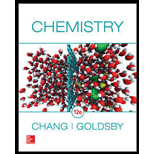
(a)
Interpretation:
An example of monoatomic cation has to be given.
Concept Introduction:
An ion is an individual atom or group of atoms has net positive charge or negative charge. Positively charged atom remains the same during
Monoatomic cation:
Monoatomic anion is the positively charged ion consists of only one atom.
Polyatomic cation:
Polyatomic anion is the positively charged ion consists of more than one atom of same or different element.
(b)
Interpretation:
An example of monoatomic anion has to be given.
Concept Introduction:
An ion is an individual atom or group of atoms has net positive charge or negative charge. Positively charged atom remains the same during chemical reaction (or change), however negatively charged atom may accept or donate an electrons. The loss of electrons results in cation.
Monoatomic anion:
Monoatomic anion is the negatively charged ion consists of only one atom.
Polyatomic anion:
Polyatomic anion is the negatively charged ion consists of more than one atom of same or different element.
(c)
Interpretation:
An example of polyatomic cation has to be given.
Concept Introduction:
An ion is an individual atom or group of atoms has net positive charge or negative charge. Positively charged atom remains the same during chemical reaction (or change), however negatively charged atom may accept or donate an electrons. The loss of electrons results in cation.
Monoatomic cation:
Monoatomic anion is the positively charged ion consists of only one atom.
Polyatomic cation:
Polyatomic anion is the positively charged ion consists of more than one atom of same or different element.
(d)
Interpretation:
An example of polyatomic anion has to be given.
Concept Introduction:
An ion is an individual atom or group of atoms has net positive charge or negative charge. Positively charged atom remains the same during chemical reaction (or change), however negatively charged atom may accept or donate an electrons. The loss of electrons results in cation.
Monoatomic anion:
Monoatomic anion is the negatively charged ion consists of only one atom.
Polyatomic anion:
Polyatomic anion is the negatively charged ion consists of more than one atom of same or different element.
Want to see the full answer?
Check out a sample textbook solution
Chapter 2 Solutions
Chemistry
- I'm having trouble with converting lewis diagrams into VSEPR diagrams. I currently have this example of C2BrCl3 which I want to turn into a lewis structure, but I'm not sure what steps I need to do in order to do so. I have the table written down, however, there's two central atoms so what would I do? There seems to be 4 electron domains on the carbon atom and no lone pairs so it would seem like this shape would be tetrahedral. Here's what I have now. Thanks!arrow_forwardWe discussed the solid phase resin using in peptide synthesis. Provide a mechanism, for its formation. DRAW THE MECHANISM.arrow_forwardPlease help. Every time I've asked an expert in the past, it's been wrong :(arrow_forward
- Please help everysingle time ive asked in the past, the solution has been wrongarrow_forwardPlease helparrow_forward(a) 21.8 Name the following compounds. & (b) Br (e) O₂N. (h) H (c) Br (d) NH2 ☑N Br H ہیں Ph (g) OMe бл .0-0.e 21.9 Draw a structural formula for each compound. (a) 2,3-Dinitrotoluene (c) Diphenylmethanol (e) p-Nitroaniline (b) 3-Propylanisole (d) m-Propylphenol (f) Pentabromobenzenearrow_forward
- Chemistry: Matter and ChangeChemistryISBN:9780078746376Author:Dinah Zike, Laurel Dingrando, Nicholas Hainen, Cheryl WistromPublisher:Glencoe/McGraw-Hill School Pub Co
 Introductory Chemistry: An Active Learning Approa...ChemistryISBN:9781305079250Author:Mark S. Cracolice, Ed PetersPublisher:Cengage Learning
Introductory Chemistry: An Active Learning Approa...ChemistryISBN:9781305079250Author:Mark S. Cracolice, Ed PetersPublisher:Cengage Learning Chemistry: Principles and PracticeChemistryISBN:9780534420123Author:Daniel L. Reger, Scott R. Goode, David W. Ball, Edward MercerPublisher:Cengage Learning
Chemistry: Principles and PracticeChemistryISBN:9780534420123Author:Daniel L. Reger, Scott R. Goode, David W. Ball, Edward MercerPublisher:Cengage Learning  Chemistry: The Molecular ScienceChemistryISBN:9781285199047Author:John W. Moore, Conrad L. StanitskiPublisher:Cengage Learning
Chemistry: The Molecular ScienceChemistryISBN:9781285199047Author:John W. Moore, Conrad L. StanitskiPublisher:Cengage Learning Living By Chemistry: First Edition TextbookChemistryISBN:9781559539418Author:Angelica StacyPublisher:MAC HIGHER
Living By Chemistry: First Edition TextbookChemistryISBN:9781559539418Author:Angelica StacyPublisher:MAC HIGHER ChemistryChemistryISBN:9781305957404Author:Steven S. Zumdahl, Susan A. Zumdahl, Donald J. DeCostePublisher:Cengage Learning
ChemistryChemistryISBN:9781305957404Author:Steven S. Zumdahl, Susan A. Zumdahl, Donald J. DeCostePublisher:Cengage Learning





